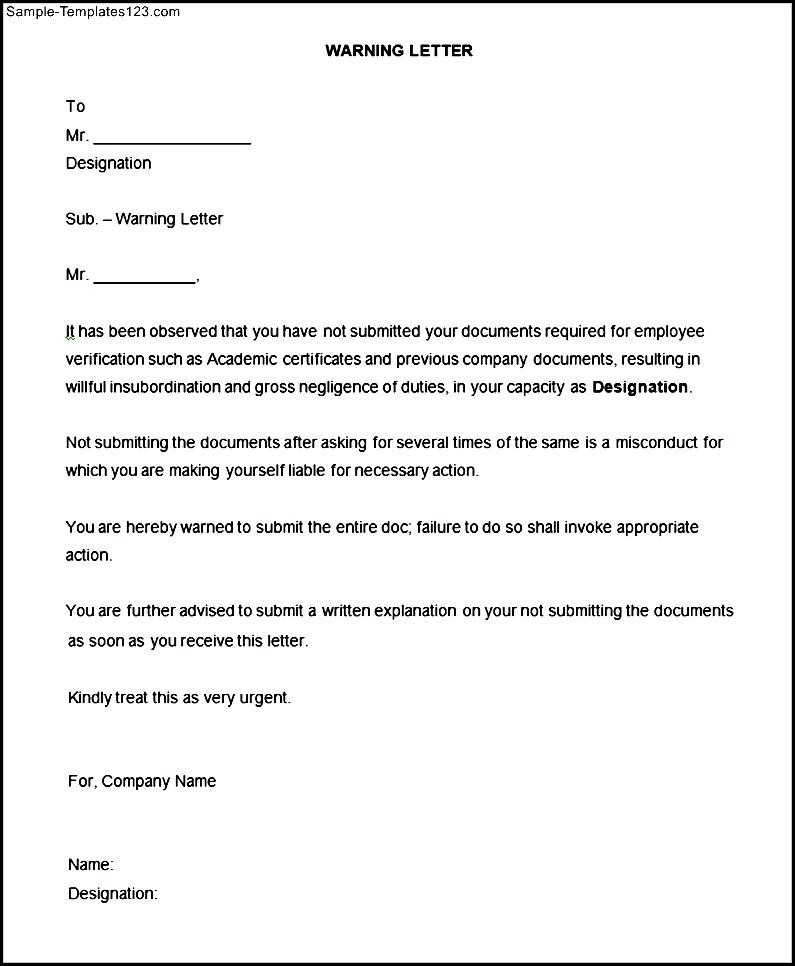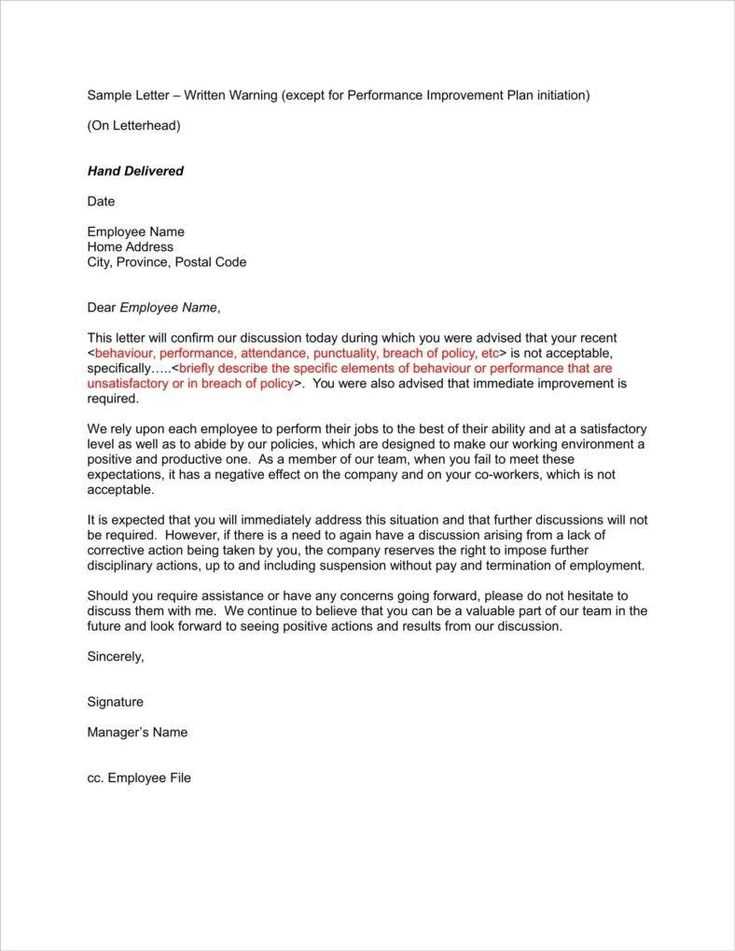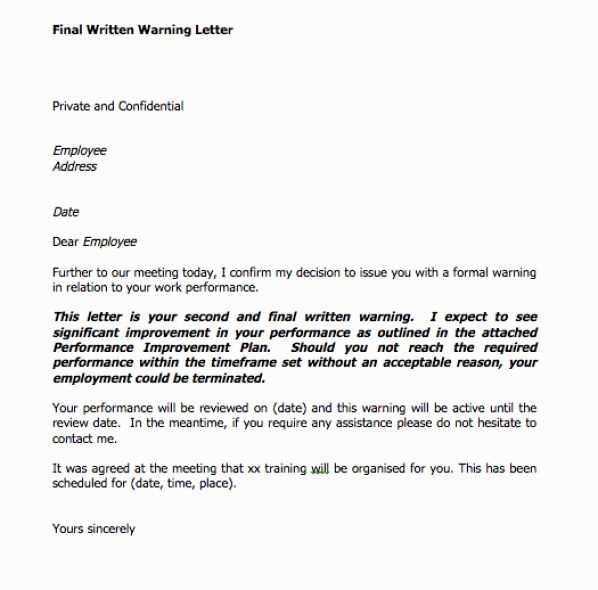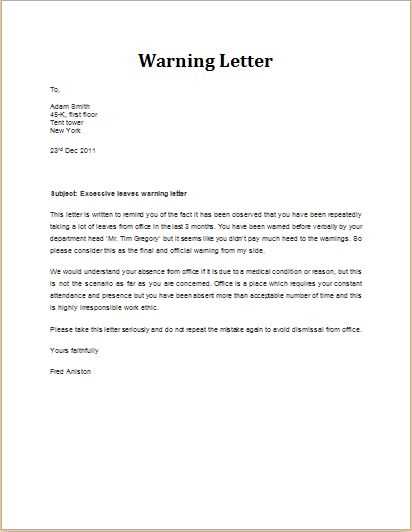Warning letter to staff template

Start with a clear explanation of the issue. Address the behavior or performance concern directly, with concrete examples if necessary. Use specific dates, incidents, or behaviors to make the situation clear.
Example: “On January 15th, you failed to meet the expected deadline for the project report, which resulted in a delay in the team’s progress. This is not the first instance where deadlines have been missed, as it happened again on December 3rd.”
Next, outline the consequences of continued non-compliance. Be direct about the potential impact on the team and the company. Offer guidance on how the situation can be improved.
Example: “If this pattern continues, it could affect your performance review and potentially result in further disciplinary action, including suspension or termination.”
Conclude by providing a path for improvement. Encourage open communication and offer support if needed, ensuring the staff member understands the seriousness of the matter while remaining open to resolving the issue together.
Example: “We expect that you will take immediate steps to improve your time management and meet deadlines. Please contact your supervisor if you need additional resources or guidance to achieve this.”
End the letter by stating the expectation for a follow-up meeting or check-in. This ensures accountability and provides an opportunity to address any concerns the employee may have.
Here are the corrected lines with repetitions removed, maintaining meaning and correctness:
Ensure the letter is clear and direct. Address the specific behavior that needs to be improved without ambiguity. Avoid using unnecessary phrases that dilute the message. Start with a clear statement of the issue, then outline the expected behavior moving forward.
Example of Revised Wording:
- Original: “We noticed that your performance has been below the expected standard and it needs improvement immediately.”
- Revised: “Your performance does not meet the expected standard and requires immediate improvement.”
Key Points for Revision:

- Remove redundant words like “immediately” if they don’t add new information.
- Focus on the issue at hand without over-explaining.
- Use concise, direct language to convey expectations clearly.
By eliminating unnecessary repetition, the message becomes stronger and more to the point. This helps ensure the recipient understands the gravity of the situation and what is expected of them moving forward.
- Warning Letter to Employees Template
Provide a clear, concise statement outlining the issue and the specific behavior or performance that led to the warning. Make sure to include dates, instances, and any previous conversations or warnings related to the situation.
Example: “On January 15th, 2025, you were absent from work without prior notification or approval. This is the third occurrence of unapproved absenteeism in the last six months.”
Next, remind the employee of the company’s expectations and the standards they are expected to meet. Reference relevant policies or guidelines from the employee handbook to ensure the message is clear and aligned with company rules.
Example: “As per the attendance policy, employees are required to inform their supervisor at least 24 hours in advance if they are unable to report to work.”
Outline the consequences if the behavior does not change, but do so in a neutral and professional tone. Avoid threats, and instead focus on clear steps and potential outcomes.
Example: “If this behavior continues, further disciplinary action may be taken, which could include suspension or termination of employment.”
Finally, offer support or a chance for the employee to explain their side of the situation. This shows a willingness to listen and resolve the issue collaboratively.
Example: “We encourage you to meet with HR to discuss any challenges you are facing that may be impacting your attendance.”
Conclude with a statement affirming the company’s desire for the employee’s success and the hope that they will improve going forward.
Example: “We value your contributions to the team and hope that you will take the necessary steps to improve your attendance. We are confident that you can turn this situation around.”
Start with a clear and direct subject line. This should immediately convey the purpose of the notice. For example: “Formal Warning Regarding [Behavior/Action]”.
Follow with a concise opening that specifies the reason for the warning. Be factual and avoid emotional language. Reference specific incidents or behaviors that led to the notice.
Outline the expectations moving forward. Explain the standards the employee must meet and the changes required in their behavior or performance. This section should include measurable and achievable goals.
State the consequences if the behavior or issue persists. Specify any potential disciplinary actions or further warnings that may follow if there is no improvement.
Conclude with an invitation for the employee to discuss the matter. Mention a follow-up meeting or review to track progress.
| Section | Description |
|---|---|
| Subject Line | Clear and direct indication of the notice’s purpose. |
| Reason for Warning | Specific behavior or incident that led to the warning. |
| Expectations | Clear explanation of the required changes or improvements. |
| Consequences | Outline the potential consequences if the issue continues. |
| Conclusion | Invitation for discussion and a follow-up meeting. |
A warning letter should be clear and direct. It needs to state the issue without ambiguity to avoid any confusion. Include the specific behavior or action that led to the warning, detailing how it violates company policies or expectations.
Details of the Incident
Start with a description of the incident. Be specific about what occurred, when it happened, and the parties involved. This provides a clear context for the employee, making it easier for them to understand the reasoning behind the warning.
Reference to Company Policies

Clearly reference the policies, guidelines, or rules that were violated. This helps to connect the behavior with the company’s expectations, making the warning both factual and grounded in established procedures.
Consequences of Further Violations should also be outlined. Explain what actions may follow if the behavior continues, including any potential disciplinary measures. Be firm but fair, focusing on the need for improvement.
Include a section on employee responsibility moving forward. Outline how they can rectify the issue or what steps need to be taken to avoid future violations. Make it clear that the company values improvement and provides an opportunity for correction.
State the specific issue without ambiguity. Be direct about the behavior or performance that needs to be corrected. Avoid vague language that might confuse the recipient.
Provide concrete examples to illustrate the issue. Clear examples help the employee understand exactly what went wrong and what should be done differently. Stick to the facts and avoid personal opinions or interpretations.
Use neutral language. Frame your message in a way that focuses on the action, not the individual. For instance, say “The report was submitted late” rather than “You are always late with your reports.”
Clarify expectations moving forward. Clearly state what changes or improvements are required. Make sure the employee understands how their actions should align with company standards.
Keep the tone professional. Address the issue without sounding confrontational or overly harsh. Focus on resolving the problem and improving future performance.
Use clear, respectful, and direct language. Avoid harsh or accusatory words that could escalate the situation. Stick to the facts, describing the issue without exaggeration. Keep sentences concise and avoid unnecessary jargon or complex terms that might confuse the reader.
Maintain a neutral, professional tone throughout. Refrain from sounding overly formal or distant, but ensure the message remains serious and authoritative. Use “we” or “you” for a more personal approach, but avoid overly casual expressions that might undermine the gravity of the situation.
Always focus on the specific behavior that needs to be addressed. Provide actionable feedback, so the recipient knows exactly how to improve. Avoid generalized statements like “you always” or “this is a pattern.” Stick to clear, relevant examples of the issue at hand.
Be mindful of language that could unintentionally cause defensiveness. Avoid using phrases that can be perceived as judgmental, such as “irresponsible” or “incompetent.” Instead, frame your feedback in a way that encourages improvement, like “this needs attention” or “let’s work on this together.”
End the letter with a forward-looking tone. Offer support for improvement and an invitation for discussion, showing a willingness to resolve the issue collaboratively. This keeps the communication constructive and solution-oriented.
Begin by clearly stating the potential repercussions of not following company policies. Identify specific actions that will lead to consequences, such as failure to meet deadlines or inappropriate conduct. Make sure these actions are understandable and easy to relate to the company’s rules. Avoid ambiguous statements–clarity is key.
Define the tiered levels of consequences. Start with mild measures like verbal warnings, followed by written notices, and then more serious steps like suspension or termination if non-compliance continues. Providing a progression helps employees understand that repeated offenses will escalate in severity.
Ensure that employees are aware of the procedure that will be followed at each step. This will make the process predictable and transparent, reducing the chance of confusion or resentment. Set timeframes for corrective actions, such as a time period within which the employee must correct their behavior or performance.
| Violation | First Step | Second Step | Third Step |
|---|---|---|---|
| Failure to meet deadlines | Verbal warning | Written warning | Suspension or demotion |
| Inappropriate conduct | Written warning | Final written warning | Termination |
Finally, make it clear that these consequences are in place to protect the team’s integrity and ensure a productive work environment. Highlight that the purpose is not punitive, but to correct behavior for the benefit of all employees. Reinforce that adherence to policies helps the team function smoothly and efficiently.
Ensure that the warning letter complies with employment laws to avoid legal challenges. Always follow company policies regarding disciplinary actions. Clarify the specific violation, providing accurate details and any evidence to support the claims.
- Specify the consequences of further violations. This helps the employee understand the potential outcomes of continued misconduct.
- Respect the employee’s rights to respond. Include a section for the employee to present their side of the story before any final decisions are made.
- Be careful not to make the letter too harsh or threatening. Maintain a professional tone while clearly stating the issue and the corrective actions required.
- Confirm that the letter is consistent with past warnings or disciplinary actions to ensure fair treatment and avoid claims of discrimination.
- Check whether the employee’s contract requires a specific process for issuing warnings, such as a formal meeting or a written acknowledgment from the employee.
Consult legal counsel if necessary to review the letter before sending it to ensure it aligns with local labor laws and the organization’s policies.
Warning Letter to Staff Template

Start the letter with a clear subject line, such as “Notice of Violation” or “Formal Warning for Misconduct”. This helps the recipient understand the purpose of the letter immediately.
In the opening paragraph, address the staff member directly and state the specific behavior or action that led to the warning. Be concise and objective in describing the incident.
Follow with a detailed explanation of the violation, providing any relevant facts, dates, or examples. Stick to the key points and avoid unnecessary details.
Next, outline the company’s expectations for future behavior. Be specific about what changes are required and the consequences if these expectations are not met.
Conclude by offering the employee an opportunity to discuss the matter further, either in person or through another form of communication. Be professional and respectful in tone.
- Clearly state the violation.
- Provide specific examples or dates if applicable.
- Outline the steps the employee must take to improve.
- Explain the consequences of non-compliance.
- Close the letter with an offer for discussion.